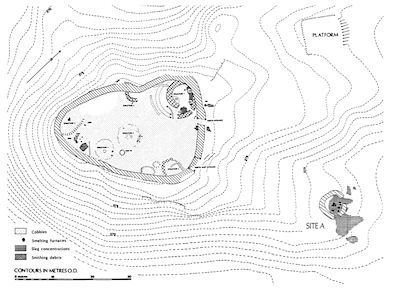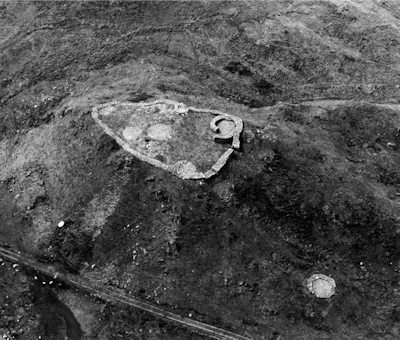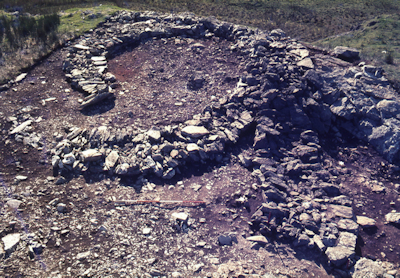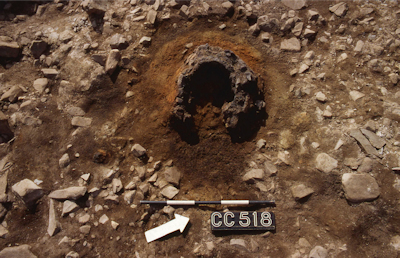
Bryn y Castell is a small (0.4ha) site in the low hills above Ffestiniog at 370m OD (SH 728 429) and is a rare example of a hillfort that has been completely excavated (Crew 1987). Previously regarded as a Dark Age site, it was shown to belong to the late prehistoric period and to be concerned primarily with the production of iron.

The stone ramparts surround the level top of a steep-sided knoll only 40m by 20m overall. There were two entrances, both through the northern rampart, one of which was subsequently blocked. The only structure visible before excavation was a stone hut just inside the north-west entrance. This was, originally, a circular structure with a central hearth and four internal postholes, later rebuilt in an unusual snail-shape and used for refining and smithing iron. Only one other hut of this type is known, in Garn Boduan hillfort.

Just outside the north rampart was an iron-smelting furnace and there were two others inside the south end of the fort. These had internal diameters of 20 to 25cm and, originally, they would have had clay shafts 20cm thick and over 50cm high. Rich bog-ores were smelted, producing about 2kg of bloom per smelt, which refined to about 0.5kg bar iron. Radiocarbon and archaeomagnetic dates from the furnaces show that the fort was occupied during the last centuries BC, with smelting ceasing around 50 AD±25, probably when the Romans arrived in this area. Within the fort two small stake-wall roundhouses were discovered, the first examples found in this area, which probably had a domestic function.

Outside the fort, to the north, was a small hut that had been used exclusively for the smelting and smithing of iron. Outside the hut was a 650kg dump of slag, with many examples of plano-convex smithing hearth bottoms. This hut had two phases, one contemporary with the hillfort, the other in the later 2nd and 3rd centuries, after the Roman influence in this area had declined.
There was an unusually wide variety of finds (for a north Welsh hillfort) from this site, including polychrome glass bangles, incised slate game boards, black-and-white stone gaming pieces, whetstones, a stone anvil, stone hammers and three examples of bearing stones for fire-drills.
The total amount of slag from Bryn y Castell was about 1200kg, significantly more than was known from any prehistoric site at the time of excavation. Experiments to reproduce the technology used there have shown that the amount of iron produced would only have been about 100kg. Each kilo of finished bar iron would have required about 100kg of charcoal and some 25 working days, demonstrating that prehistoric iron had considerable value (Crew 1991).

More recent excavations at the broadly contemporary open settlement at Crawcwellt, some 10km to the south, produced over 6000kg of slag. The furnaces there were located inside a series of stake-wall roundhouses and this site is probably more typical of the many late prehistoric iron production sites that remain to be discovered.
Internet Archaeology is an open access journal based in the Department of Archaeology, University of York. Except where otherwise noted, content from this work may be used under the terms of the Creative Commons Attribution 3.0 (CC BY) Unported licence, which permits unrestricted use, distribution, and reproduction in any medium, provided that attribution to the author(s), the title of the work, the Internet Archaeology journal and the relevant URL/DOI are given.
Terms and Conditions | Legal Statements | Privacy Policy | Cookies Policy | Citing Internet Archaeology
Internet Archaeology content is preserved for the long term with the Archaeology Data Service. Help sustain and support open access publication by donating to our Open Access Archaeology Fund.